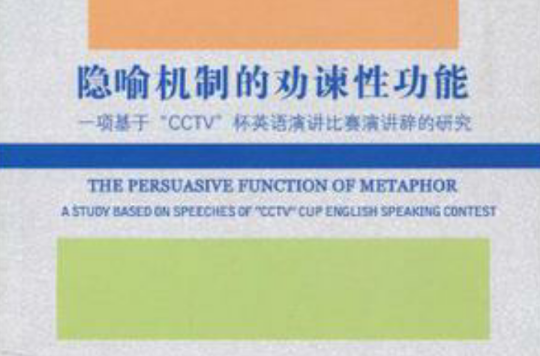《隱喻機制的勸諫性功能》是2010年中國社會科學出版社出版的圖書,作者是孫毅。
基本介紹
內容簡介,作者簡介,圖書目錄,
內容簡介
《隱喻機制的勸諫性功能:一項基於"CCTV"杯英語演講比賽講辭的研究》主要內容簡介:認知語義學者萊考夫與詹森在其著作《我們賴以生存的隱喻》中首次構建起概念隱喻理論的框架,這標誌著隱喻研究擺脫了以文學和修辭學為本的傳統隱喻理論的束縛,進入到嶄新的認知科學領域。學界已普遍意識到隱喻不僅是語言的表達手段,更是一種獨具魅力、以一事物描寫另一相關事物的思維方式。人類的認知總是遵循由近而遠、由淺而深、由具體到抽象、由已知到未知的發展規律,而認知的深化和發展在相當大程度上是依賴於隱喻機制的。
認知語言學者往往過於強調由特定語境中抽象出來的人所共有的普遍認知操作,將神經生物學原理生硬地套用在隱喻的生成和闡釋的過程中,認為所有隱喻概念均是體驗性基礎隱喻的必然蘊涵,而忽略了諸多社會文化變體及其對概念孵化過程的影響,這犯了簡化主義的錯誤。與此同時,批評性話語分析也應契合諸多認知元素而得到更大的擴充。隱喻表達式是作為話語基礎的認知結構與穿插其間的意識形態之間的媒介,隱喻對部分語義凸顯而對其餘語義遮蔽的功能使對具有意識形態特性的語言選擇研究有據可依。本研究證明兩大理論路徑究其實質具有相通共融之處,應聯合起來形成一股強大的探索洪流,發揮更大的闡釋效應。
在方法論方面,本研究提出,在甄別隱喻圖譜分布的過程中應將定量方法和定性方法、語料庫語言學與“學術直覺”有機結合起來,共同保證將所有符合標準的隱喻用法統統納入考察範圍,為進一步分析隱喻的社會文化特性鋪平道路。
在花樣繁多的修辭手段當中,隱喻機制是一種極具代表性、十分高效的勸諫性策略,可以完美地將人們在日常生活中對普通體驗的理解與能夠激發強烈內心情感的文化價值結合起來。本研究指出,隱喻機制通過指稱司空見慣的個人體驗和社會活動來與廣大聽眾構建起儘量多的共同點,是演講者傳播核心信念、價值觀念和哲學理念等勸諫性要素的母體和不竭源泉。
本研究以相當規模的、隱喻表述俯拾皆是的“CCTV”杯全國大學生英語演講辭為語料,將批評性話語分析與概念隱喻理論緊密聯繫起來,嘗試性地辨認、分析和詮釋公眾演講語篇中具有特定意識形態的隱喻機制的重大勸諫性功能。
作者簡介
孫毅,男,江蘇南京人。畢業於上海外國語大學英語學院,獲英語語言文學博士學位。曾獲得“外教社”一等獎學金、“寶鋼”教育基金優秀學生獎、上海市“優秀研究生畢業生”等榮譽。復旦大學外國語言文學博士後流動站進站人員。現就職於西安外國語大學《外語教學》暨《西安外國
圖書目錄
Acknowledgements
內容提要
Abstract
List of Figures
List of Tables
Lists of Concordancing Outcomes by ' AntConc3.2.0w( Windows)'
Chapter One Introduction
1.1 The significance of studying metaphor in public speaking
1.2 Objectives of the present study
1.3 Outline of the dissertation
Chapter Two Review of Related Literature
2.1 Various previous approaches towards metaphor
2.1.1 The Aristotelian approach
2.1.2 The Vieo view
2.1.3 Semantic approaches
2.1.4 Generative approaches
2.1.5 Pragmatic approaches
2.1.6 Conceptualist approach
2.2 The necessity of incorporating Critical Discourse Analysis in researching metaphor
2.2.1 Essentials of Critical Discourse Analysis
2.2.2 Reconciliation of CDA and cognitive metaphor research
2.3 Summary
Chapter Three Methodology in Identifying and Deciphering Metaphors: The Hybridization of Quantitative and Qualitative Analyses
3.1 Quantitative analysis
3.1.1 Imperfections of cognitive metaphor theory in identifying metaphors
3.1.2 Values of corpus-based research
3.1.3 Corpus-based description in the dissertation
3.2 Qualitative analysis
3.3 Metaphor deciphering in CDA
3.3.1 Metaphor description
3.3.2 Metaphor interpretation
3.3.3 Metaphor explanation
3.4 Summary
Chapter Four Distribution and Elucidation of Conceptual Metaphors in "CCTV" Cup English Speaking Contest
4.1 The gist of the art of public speaking
4.2 Distribution and elucidation of conceptual metaphors in public speaking corpus
4.2.1 Journey metaphors
4.2.2 Building metaphors
4.2.3 Conflict metaphors
4.2.4 Light metaphors
4.2.5 Relationship metaphors
4.2.6 Temporal metaphors
4.3 Summary
Chapter Five Persuasive Function of Metaphor in Public Speaking
5.1 Metaphor and persuasion in public speaking
5.2 Metaphor and intentions
5.3 Metaphor and emotions
5.4 Metaphor and evaluation
5.5 Metaphor and analogical reasoning
5.6 Summary
Chapter Six Conclusion
6.1 A brief summary of the study
6.2 Implications: using metaphor for pedagogical purposes
6.2.1 Enhancing learners' awareness towards metaphor
6.2.2 Metaphor and speaking
6.2.3 Metaphor and writing
6.3 Problems and limitations of this research
6.4 Suggestions for further studies
Appendices: Corpora of Speeches of the Fifth "CCTV" Cup English Speaking Contest
Bibliography
內容提要
Abstract
List of Figures
List of Tables
Lists of Concordancing Outcomes by ' AntConc3.2.0w( Windows)'
Chapter One Introduction
1.1 The significance of studying metaphor in public speaking
1.2 Objectives of the present study
1.3 Outline of the dissertation
Chapter Two Review of Related Literature
2.1 Various previous approaches towards metaphor
2.1.1 The Aristotelian approach
2.1.2 The Vieo view
2.1.3 Semantic approaches
2.1.4 Generative approaches
2.1.5 Pragmatic approaches
2.1.6 Conceptualist approach
2.2 The necessity of incorporating Critical Discourse Analysis in researching metaphor
2.2.1 Essentials of Critical Discourse Analysis
2.2.2 Reconciliation of CDA and cognitive metaphor research
2.3 Summary
Chapter Three Methodology in Identifying and Deciphering Metaphors: The Hybridization of Quantitative and Qualitative Analyses
3.1 Quantitative analysis
3.1.1 Imperfections of cognitive metaphor theory in identifying metaphors
3.1.2 Values of corpus-based research
3.1.3 Corpus-based description in the dissertation
3.2 Qualitative analysis
3.3 Metaphor deciphering in CDA
3.3.1 Metaphor description
3.3.2 Metaphor interpretation
3.3.3 Metaphor explanation
3.4 Summary
Chapter Four Distribution and Elucidation of Conceptual Metaphors in "CCTV" Cup English Speaking Contest
4.1 The gist of the art of public speaking
4.2 Distribution and elucidation of conceptual metaphors in public speaking corpus
4.2.1 Journey metaphors
4.2.2 Building metaphors
4.2.3 Conflict metaphors
4.2.4 Light metaphors
4.2.5 Relationship metaphors
4.2.6 Temporal metaphors
4.3 Summary
Chapter Five Persuasive Function of Metaphor in Public Speaking
5.1 Metaphor and persuasion in public speaking
5.2 Metaphor and intentions
5.3 Metaphor and emotions
5.4 Metaphor and evaluation
5.5 Metaphor and analogical reasoning
5.6 Summary
Chapter Six Conclusion
6.1 A brief summary of the study
6.2 Implications: using metaphor for pedagogical purposes
6.2.1 Enhancing learners' awareness towards metaphor
6.2.2 Metaphor and speaking
6.2.3 Metaphor and writing
6.3 Problems and limitations of this research
6.4 Suggestions for further studies
Appendices: Corpora of Speeches of the Fifth "CCTV" Cup English Speaking Contest
Bibliography

